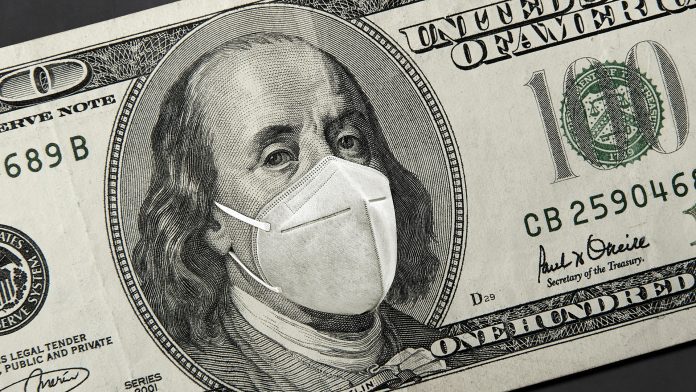
A new study in the United States has found that wearing face masks for at least two weeks after achieving COVID-19 vaccination targets could have substantial economic benefits for the country, saving billions.
US researchers performed a series of computer simulations to evaluate the effectiveness of mitigating the spread of COVID-19 by wearing face masks. They discovered that implementing them in indoor public spaces and public transportation for at least two weeks after vaccination targets are met – with a minimum of 70% – saves lives and billions of dollars in the process. The most significant economic and health benefits of wearing face masks are seen when the final population vaccination coverage level is lower.
The study’s findings are published in The Lancet Public Health journal.
Containing COVID-19
In the US, wearing face masks was widely used in the early stages of the pandemic; however, many rules have relaxed following the surge of the Delta and Omicron variant, despite vaccination rates remaining below potential herd immunity thresholds. The exact herd immunity thresholds are currently unknown, although the World Health Organization (WHO) has set a global vaccination coverage target of 70% by mid-2022.
A new tool was recently released by the US Centers for Disease Control and Prevention (CDC) to provide advice on wearing masks based on the levels of COVID-19 in more than 3,000 counties. These are recommendations, not mandates, and are designed to inform face mask policies for states and municipalities.
Dr Bruce Y. Lee, the senior author of the study from the CUNY Graduate School of Public Health and Health Policy, commented: “Our findings emphasise that vaccination alone is not enough to control the pandemic and that overlapping layers of protective measures are needed to limit economic impacts and deaths. The newly released recommendations from CDC come at a time when many places in the USA are also beginning to consider easing mask requirements, and the choice to wear a mask will come down to individual decisions or decisions of private businesses. Our model represents the US population, but the breadth and scale of the simulated scenarios mean the results are also applicable to other countries.”
Earlier research showed that wearing face masks can effectively stop the spread of COVID-19, but the economic value of maintaining these infection control measures at differing levels of vaccination coverage, has not been identified.
Benefits of wearing face masks
The researchers designed a computational model that mirrored the spread and impact of COVID-19 among the US population of over 327 million people, simulating face mask use before and after meeting vaccination coverage levels under a range of circumstances. These scenarios varied the final population vaccination levels and the date these targets were reached, in addition to the levels of mask use and when restrictions ended.
In all of the simulated scenarios, wearing face masks was cost-effective for between two and ten days after hitting population vaccination targets. Maintaining mask use was always found to be cost-effective and typically cost-saving when the daily cost of mask-wearing per person was less than $1.25. The combination of using N95, surgical, and cloth masks between March to July 2020 achieved a cost of $0.32 per person per day.
The lower the vaccination coverage, the more considerable to benefits of wearing face masks were. Estimations showed that if the US achieved vaccination coverage of 90% by 1 May 2022, maintaining face mask use would save $13.3 bn in societal costs and $2.4 bn direct medical costs, as well as 6.29 million COVID-19 cases, 136,700 hospitalisations, and 16,000 deaths. Moreover, achieving vaccination coverage of 80% by 1 July 2022 would increase savings to $16.7 bn in societal costs, $2.9 bn in direct medical expenses, and avert 7.66 million cases, 174,900 hospitalisations, 20,500 deaths.
The longer it takes to reach the final vaccination level correlates to the greater benefits of maintaining face mask use. For example, reaching vaccination coverage by 1 July 2022 would save $18.7 bn in societal costs, $3.3 bn in direct medical costs, 8.57 million cases, and 23,200 deaths.
Furthermore, the emergence of variants that are more transmissible boosts the effectiveness of wearing face masks, as does the reduced efficacy of vaccines due to falling immunity and novel variants. Additionally, increasing social mixing of people of varying ages by reducing social distancing mandates increases the benefits of masks. In all simulations, wearing face masks saved billions of dollars and significantly reduced hospitalisations and deaths.
Dr Peter Hotez, the co-author of the study from the National School of Tropical Medicine at Baylor College of Medicine, said: “Our findings offer some light at the end of the tunnel, suggesting that face mask use doesn’t have to continue forever, but that it remains an important tool to stop the spread of COVID-19 as we enter the next phase of the pandemic.”
“Virus transmission does not stop as soon as population vaccination targets are met but maintaining mask use for just a few short weeks after reaching these targets can deliver tremendous economic and health benefits,” added Dr Maria Elena Bottazzi, of the National School of Tropical Medicine at Baylor College of Medicine
Study limitations
A limitation of the models is the simplifications of real-life that cannot account for every possible outcome. Although face mask effectiveness at stopping COVID-19 transmission was fixed for the duration of the simulations, this may vary daily and with local policies. Additionally, the simulations assume vaccination coverage of the entire population, despite some age groups not being eligible, such as those aged five and under.










